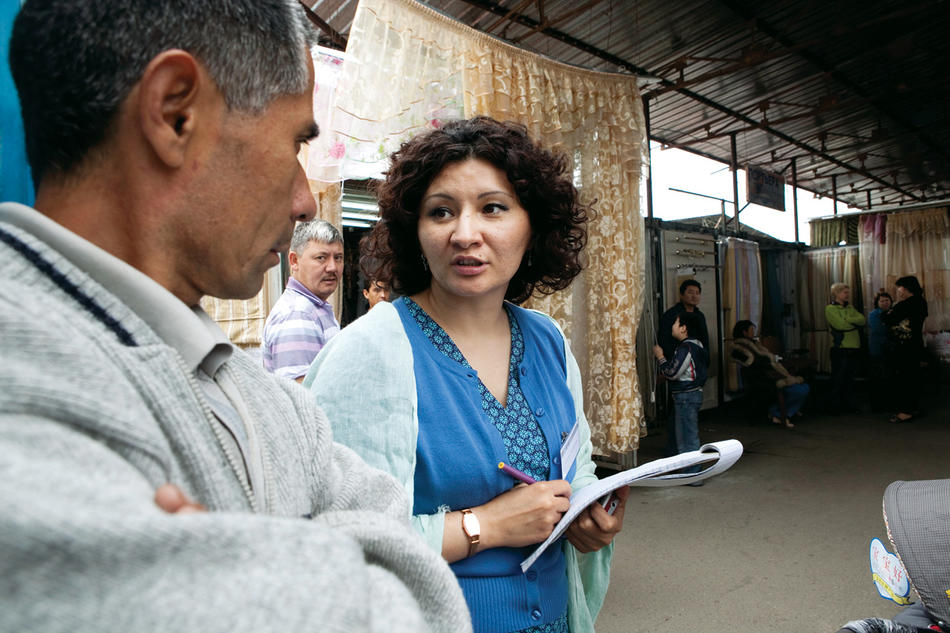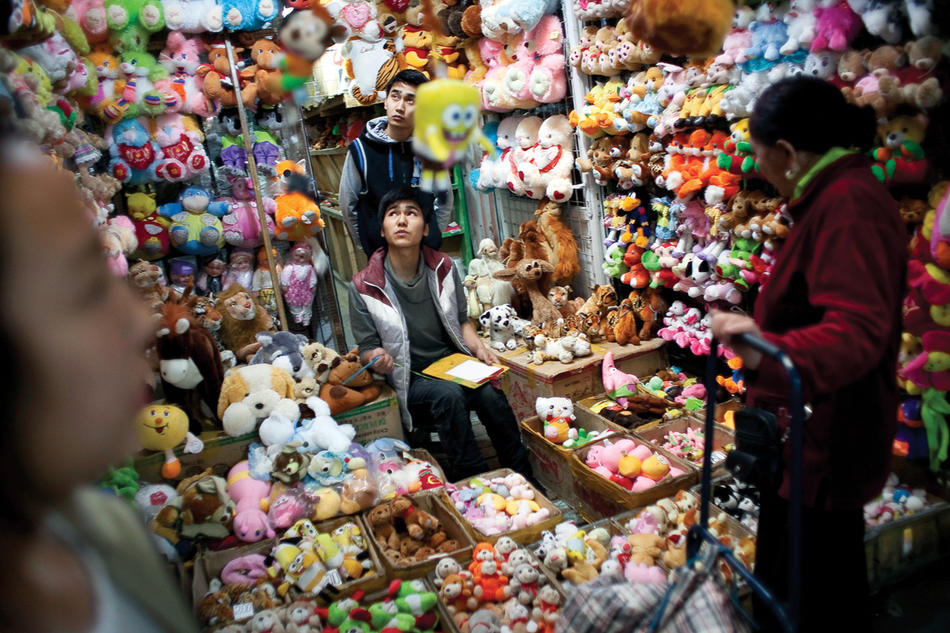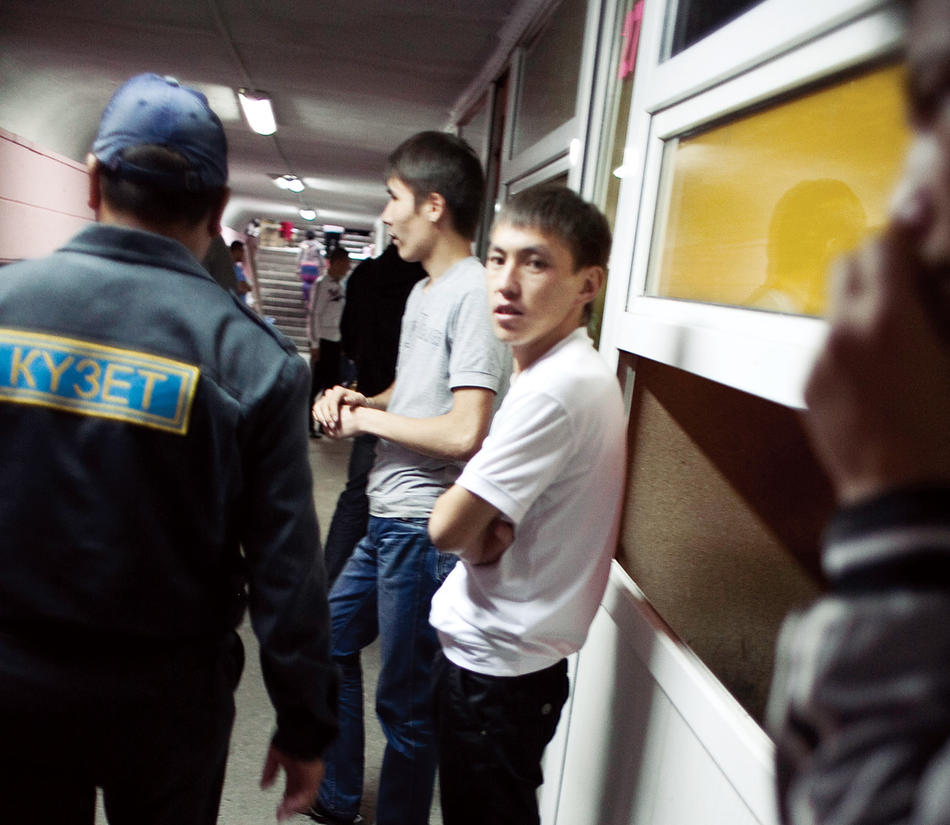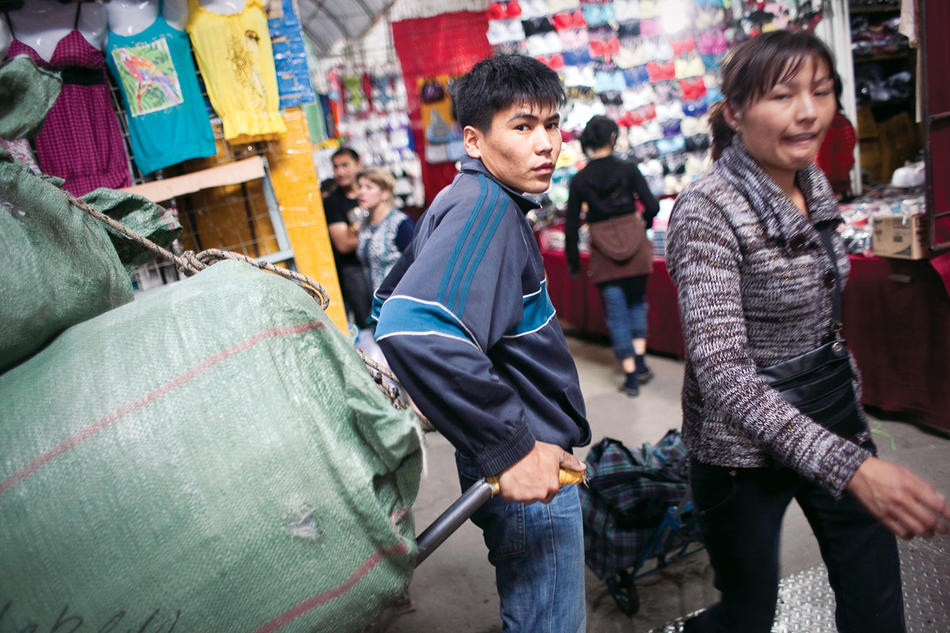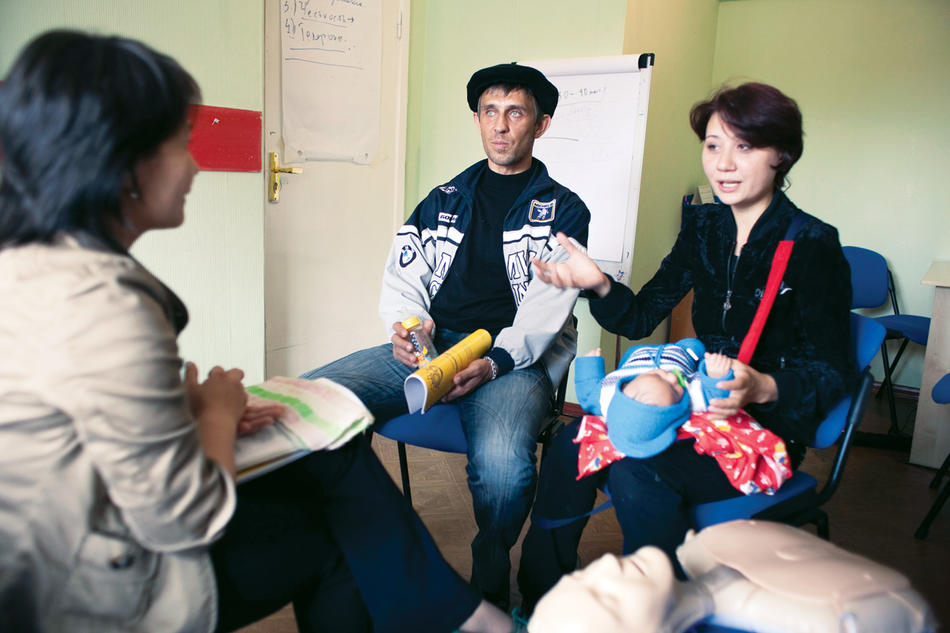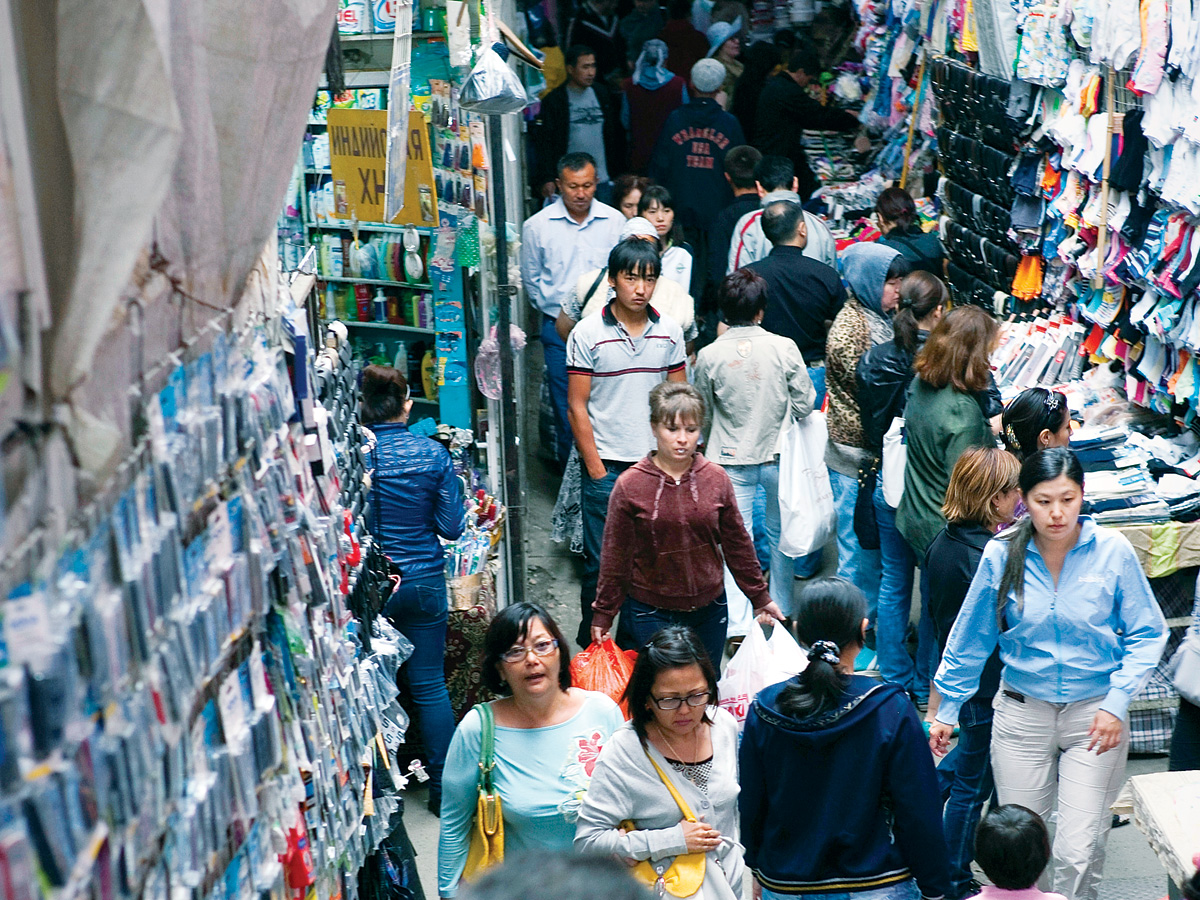
Barakholka Market is a place where you can buy anything. Nestled in the foothills of Kazakhstan’s Tian Shan Mountains, three miles northwest of the city of Almaty, it is a noisy, congested, and chaotic emporium at the edge of the desert. When you first enter its maze of zigzagging aisles that tower overhead with sneakers, pirated DVDs, fake leather handbags, fur hats, stereo speakers, generic Legos, black-market pharmaceuticals, and dirty magazines, you wonder: How will I find my way out? There are no maps or directories, and Barakholka is enormous, occupying some 100 acres. Locals navigate the place by remembering where specific types of merchants are situated — all 170 cosmetics vendors are crammed together, as are all 200 jewelers, and so on. Dozens of languages are spoken here, so urgent messages get communicated by volume alone. “Out of the way! Out of the way!” shouts a man in Russian, sticking his elbow in your back, and storming past with a refrigerator on a dolly.
For the tens of thousands of Kazakhs who shop here daily, Barakholka is a junk shop, a department store, a farmer’s market, and a red-light district rolled into one. For the 30,000 men and women who work here, it is also home. They come from Kazakhstan’s poorer southern neighbors — Tajikistan, Uzbekistan, Kyrgyzstan, and Turkmenistan — and sleep in dilapidated concrete tenements that encircle Barakholka. They awake at three every morning to prepare their stalls, and by late afternoon, after the shopping ends, they hit the cafés and gambling dens on the outskirts of the market.
“Over there is where they get girls,” says Sholpan Primbetova ’09SW, a Kazakh woman who studies life in this market. She points to two teenagers at an outdoor café wearing halter tops and blank stares. “A man soon will sit down next to one of them, offer to buy her a drink, and things will proceed from there,” says Primbetova. “The men tend not to think of women they find this way as prostitutes, but as friends who need money.”
For the past three years, Primbetova and other social scientists at Columbia’s Global Health Research Center of Central Asia (GHRCCA), which is based in Almaty, have been studying the sex lives and drug habits of men who work in this market. They want to know if Barakholka is a hot spot for the transmission of HIV, which is spreading faster in Central Asia and Eastern Europe than anywhere else in the world. The researchers worry that migrant workers temporarily away from their families are having sex with prostitutes or shooting heroin, contracting HIV, and then infecting their wives when they return home.
Primbetova demonstrates how she recruits study subjects. She walks up to a Tajik shoe seller, a man of about 25 in a sleeveless tee. He seems nervous. Within seconds, half a dozen other shoe sellers have surrounded her. They prod Primbetova’s arms in a way that expresses more curiosity than aggression. “This is typical,” she whispers. “Immigrant men, particularly the Tajiks, are very protective of one another and tend to stick close together. It’s tough to get them to speak to you one-on-one.”
Primbetova, speaking in her native Russian, introduces herself as a researcher and asks the men if they’re familiar with AIDS. They chuckle, but say little. She asks if they use condoms. “But I’m married,” says the first shoe seller, striking a defiant pose. One of his friends chimes in: “Still, we all have girlfriends here.” The first man grins bashfully. “Yeah, we have girlfriends, and we use condoms.”
Unfortunately, that’s not what the researchers are finding. So far, they’ve conducted in-depth, private interviews with 422 migrant workers. Few of them inject drugs. But more than a quarter admit to having had sex with prostitutes recently, nearly half say they have multiple sex partners, and only a small number use protection. Furthermore, they know practically nothing about AIDS. They’d be hard-pressed to learn, since there are no HIV-prevention clinics anywhere near the market. A condom, it seems, is one thing that’s difficult to find in Barakholka.
“A bad situation,” says Columbia social work professor Nabila El-Bassel ’87SW, who directs the GHRCCA and oversees this research. “The potential for AIDS to spread here is definitely frightening.”
What should be done? Should Kazakhstan's government, perhaps, transfer some of its public-health resources to Barakholka? Until now, it would have been impossible to say if this would be money well spent because no AIDS research has ever been conducted here. In fact, little AIDS research has been conducted among migrant workers anywhere in Central Asia.
“This is remarkable,” says El-Bassel, “considering that AIDS is on the verge of becoming pandemic in the region and there are millions of migrant workers in Kazakhstan alone.”
By conducting studies in Barakholka Market and elsewhere in Central Asia, El-Bassel hopes to produce a clearer picture of how AIDS is spreading and might be controlled. In the process, she’s helping to train a new generation of health researchers here. Most of the fieldwork that GHRCCA conducts is done by a group of 25 Kazakhs, who El-Bassel says will be able to do this work on their own eventually. Several of these young researchers, such as Primbetova, attended Columbia’s School of Social Work; others received short-term training from the school’s faculty both in New York City and in Kazakhstan. To do this work, they’ve also given up careers in medicine, taken bruises in old-fashioned Soviet politics, and even withstood arrests and police interrogations.
In the dark
Over the past 15 years, AIDS has spread at an alarming rate throughout Central Asia and Eastern Europe. In Kazakhstan, the number of new HIV cases has doubled every two years. The epidemic is fueled, experts believe, by a breakdown in social conditions in former Soviet republics. While the transition from communism has improved living standards for many people in this part of the world, it has also introduced the novel problem of unemployment, which, in turn, has led to spikes in drug abuse, prostitution, and migration — all factors that contribute to the spread of AIDS.
In southern Kazakhstan, where El-Bassel’s team is operating, conditions are especially fertile for disease. Not only are poor migrant laborers flocking here, but drug dealers are passing through on their way from Afghanistan to Russia, making heroin cheaply available along the way. (The Columbia researchers have dubbed their work at Barakholka Market the “Silk Road Project,” an allusion both to Almaty’s location along the ancient trade route and to the current migration and drug traffic.) In some towns in southern Kazakhstan, as many as one in seven adults are heroin addicts.
Kazakhstan’s response to AIDS, meanwhile, has been slow. According to a recent United Nations report, very few people in Kazakhstan are aware of the risks of AIDS or have been tested, and condom-distribution and needle-exchange programs are not widely available. This isn’t for a lack of financial resources in the country: Since becoming independent in 1991, Kazakhstan has emerged as the economic powerhouse of Central Asia, with oil and natural-gas industries that attract billions of dollars in Western investment every year. The country has tripled its spending for health care, education, and other public services in the past decade.
To understand why Kazakhstan isn’t doing a better job combatting AIDS, it’s helpful to speak to Maksut K. Kulzhanov, the head of the Kazakhstan School of Public Health. Kulzhanov has been a vocal supporter of Columbia’s GHRCCA since its founding in 2007, and he is now a member of the center’s scientific advisory board. His school, which is operated by the country’s ministry of health, is located on the outskirts of Almaty. To get there, you rumble down a long, pothole-strewn driveway. The building that eventually appears behind a copse of unpruned apple trees has large pieces of concrete missing from its façade. Inside, corridors are dimly lit and walls are veined with cracks.
Kulzhanov, a neatly dressed man, greets visitors with a two-handed shake. Once seated at an oak table, he explains that Kazakhstan has a long history of shortchanging public-health research, which means that health officials often lack the information they would need to respond effectively to new problems. “Under the Soviets, our government had little interest in promoting an open spirit of inquiry on this kind of thing,” Kulzhanov says. “Health-policy decisions, like all policy decisions, were made in a top-down manner.”
Kazakhstan created its school of public health, the nation’s first, in 1997, and the government plans to soon open a second in the capital city of Astana. But the country still has too few people trained to conduct health research, Kulzhanov says. This has crippled the nation’s response not only to AIDS but also to tuberculosis and hepatitis C, which are threatening to become epidemic. The lack of research is a particular liability in the fight against AIDS, Kulzhanov says, because there are powerful cultural forces in Kazakhstan that resist funding AIDS programs. Most citizens of this country are Muslim, he points out. Also, in Kazakhstan there is intense prejudice that lingers from Soviet culture against drug addiction, homosexuality, and other behaviors regarded as antisocial. If health officials are to secure adequate funds for HIV-prevention programs, Kulzhanov says, they’ll need to give lawmakers political cover by providing them very specific answers to questions such as: How will you reach out to these marginalized people? What messages will they find persuasive? Whom will you target first?
“But even the best-intentioned health professionals in my country,” he says, “can’t really answer these questions.”
Hearts and minds
A dozen GHRCCA researchers are packed into their tiny, run-down field office in the attic of a restaurant in Barakholka Market. The mood is tense. It’s a Thursday afternoon in late June, and the team is about to expand its study to include some 2000 additional market workers, but recruitment is down.
El-Bassel, 54, is at the meeting. As the principal investigator for GHRCCA’s studies, she visits Kazakhstan several times a year and holds daily videoconferences with her Kazakh staff when she’s back in her New York City office. She is a warm and unassuming person, almost bashful, and she has a teacher’s knack for drawing out the contributions of her colleagues, preferring the role of arbiter to orator.
A Kazakh woman in her early 20s starts things off: “A lot of the guys I’m approaching don’t understand the whole confidentiality thing.” El-Bassel suggests a game of role-playing, in which the researchers demonstrate their recruitment pitches. After observing one another, they decide they need to communicate more clearly to potential subjects that participation is anonymous. “Be extremely direct on this point,” says El-Bassel. “Say to them, ‘This is all secret,’ and ‘Nobody will know who you are.’”
This work has been arduous from the start. The local researchers employed by GHRCCA are all college-educated, but few of them have studied in the West. So El-Bassel and her senior staff members, most of whom are Columbia alumni, have taught them modern research methods from scratch.
“Our subjects, meanwhile, have absolutely no concept of what research is,” El-Bassel tells me later. “We need to explain all the basics — for example, that we’re generating knowledge that will benefit their community. It’s not unlike working in a traditional culture.”
Lately, the work has become increasingly difficult. The trouble started in April, when an uprising in nearby Kyrgyzstan triggered violence between ethnic Kyrgyz and Uzbeks in that country. Soon there were news reports that Kazakhstani police were rounding up and deporting Kyrgyz immigrants, apparently for fear that the fighting would spill over the border into Kazakhstan. Since then, market workers have been reluctant to talk. “Many of them are undocumented immigrants,” says El-Bassel, a Palestinian who grew up in Tel Aviv. “They’re afraid we’re police or immigration officials.”
The researchers themselves have been caught in the security crackdown. In May, four GHRCCA researchers, with clipboards and questionnaires in hand, were arrested by police while recruiting in the market. They were interrogated in a market jailhouse for four hours before GHRCCA senior staff were able to secure their release. “The police asked about their relationship to political opposition parties inside Kazakhstan,” says Primbetova, who helped get her colleagues out of jail. “I think they worried that we’re trying to stir up political unrest.”
So today, El-Bassel and GHRCCA deputy director Louisa Gilbert ’83BC, ’09SW, an associate research scientist at the Columbia University School of Social Work, have invited 10 entrepreneurs who manage Barakholka’s administrative affairs to meet with their staff. El-Bassel and Gilbert want to patch up their relationships with these market bosses. “Things got strained after the arrests,” says El-Bassel. The bosses have since promised El-Bassel that police who patrol the market won’t bother her team again; the Columbia researchers now want to ask the bosses to reassure their workers that it’s safe to participate in their study.
When the market bosses arrive, Assel Terlikbayeva ’03SW, a native Kazakh who directs GHRCCA’s local staff, gives them an overview of the team’s preliminary findings. Then she explains that controlling disease in Barakholka will be good for business. The bosses listen attentively and nod, needing no convincing.
When Terlikbayeva opens the floor to questions, however, it quickly becomes apparent how difficult it’s going to be to create a comfortable atmosphere for the workers. First to speak is a middle-aged Russian woman, with heavy makeup and dyed-blond hair, who represents the market’s 1300 shoe vendors. “Forget about this study being voluntary,” she says. “We should make the workers take part.”
Terlikbayeva shoots a sidelong glance at El-Bassel, composes herself, and calmly explains: “It has to be voluntary,” she says. “We don’t force anybody. This is a standard that other people established a long time ago, and it is a good standard.”
A man raises his hand: “If people have AIDS, they won’t want everybody else to know,” he says. “They’ll never take part.”
Terlikbayeva reassures him that the results will stay confidential. “If a subject needs medical treatment, we refer him to a clinic,” she says. “But we do it discreetly.”
After a few more questions, the bosses seem satisfied. They agree, as a next step, to hold a health fair where workers will be educated about the Columbia project. “I think this could be good,” says one of the bosses. “Good for everybody.”
Leaving the meeting, Terlikbayeva looks tired. “We have to be very patient,” she says. “We’re not simply doing research; we’re trying to change a culture.”
From the ground up
Terlikbayeva, 32, is deadly serious in demeanor, which gives her an imposing presence, despite her diminutive, four-foot-ten-inch frame. Like many young Kazakh professionals, she is also fiercely devoted to the project of building her new nation. This reporter, over the course of four days in Kazakhstan, saw her go toe-to-toe with a number of high-ranking bureaucrats to argue for more domestic AIDS spending. When I once made the faux pas of referring to Kazakhstan as a developing country, she bristled. “In the West, it took hundreds of years for research practices to develop,” she said. “We’re trying to do it in 10 or 20. People need to appreciate that.”
In 2001, Terlikbayeva was just out of medical school and working as a physician in the toxicology ward of an Almaty hospital when she decided to ditch her career as a doctor. At the hospital, she was seeing lots of overdose victims, many of whom she knew were likely to have AIDS. “Other doctors regarded them as subhuman,” she says. “Patients would be lying around untreated on gurneys and the staff would walk by like they were invisible. We rarely referred anybody for AIDS testing. I wanted to find out what these people’s lives were like. I wanted to help them before they ended up in a hospital.” The next year, Terlikbayeva enrolled in the Columbia University School of Social Work, which has a strength in training health researchers.
In New York City, Terlikbayeva began working for El-Bassel on an AIDS research program called Project Eban, which she would later help transplant to Kazakhstan, forming the basis of GHRCCA. Project Eban tries to control the spread of AIDS in the U.S. by teaching couples to discuss their feelings. How is that related to HIV prevention? El-Bassel has shown that if a woman feels comfortable talking about her emotions to her boyfriend or husband, she’s more likely to demand that he use a condom. El-Bassel’s colleagues say this is her major contribution to her field.
Terlikbayeva recognized that this approach could slow AIDS in her own country. She thought that women in Kazakhstan also ought to be encouraged to ask their partners to use clean needles if they shoot heroin, since a lot of HIV transmission in Kazakhstan occurs among drug users. So in 2003, a few months before Terlikbayeva received her master’s degree from Columbia, she and El-Bassel applied to the U.S. National Institute of Mental Health for a $100,000 grant to adapt the program for Kazakhstan. They got the grant and soon Terlikbayeva was overseeing Project Renaissance, a small pilot study in the drug-ridden city of Shu.
Since Project Renaissance was launched in 2005, Columbia’s work in Kazakhstan has grown steadily. That project received a big boost in 2008 when Terlikbayeva and El-Bassel received a $3.5 million grant from the U.S. National Institute on Drug Abuse to move it to Almaty. Now, Project Renaissance is housed in a wing of the Kazakhstan School of Public Health and is operating a five-year study with 400 couples. The GHRCCA researchers are fine-tuning their approach for Kazakh culture. They’ve discovered, for instance, that women here are so nervous about asking their partners to use condoms that they need to participate in all-female group-therapy sessions first.
The project in Barakholka Market has grown, too, despite some curious initial findings. The pilot study of 422 market workers, which was completed last year, showed that only one of them was HIV positive. That’s good news, but it might seem to call into question the project’s relevance. I asked El-Bassel if she had looked under the wrong stone. She insisted, however, that Barakholka must still be regarded as a potential gateway location for HIV transmission. “Workers here are having lots of unsafe sex with prostitutes, among whom HIV rates are known to be very high,” she said. “And if you want to stop AIDS, you need to go where it can cross over from marginalized groups, like prostitutes and drug users, into the wider population. The AIDS epidemic in Central Asia is still gaining steam, and Barakholka is a place where it could explode.”
U.S. funders apparently agree: The National Institute of Mental Health awarded GHRCCA $2.4 million last year to determine how best to prevent sexually transmitted diseases from spreading among migrant workers in the region. El-Bassel’s team is now trying to learn, among other things, if an outreach program should be launched at Barakholka to provide HIV-prevention services to all workers, or if it would be more efficient to direct such services to prostitutes.
“Strictly in humanitarian terms, what El-Bassel’s team is doing is extremely valuable,” says Laura M. Kennedy, an official at the United Nations Educational, Scientific, and Cultural Organization in Kazakhstan. “Undocumented workers rarely get their health needs addressed, anywhere in the world. The first step in getting them any services is generating some knowledge about their lives. In Kazakhstan, we’re just beginning to figure out what’s happening within this population.”
On their own
To date, nearly 1000 people have participated as subjects in GHRCCA research, and in doing so they’ve received HIV-prevention tips and have been screened for sexually transmitted diseases. But El-Bassel doesn’t intend for GHRCCA to deliver these services on a large scale. Rather, she hopes that the Kazakhstani government, or perhaps an international aid agency, will step in to provide services based on her team’s successful experiments.
This is already happening. The Kazakhstani government recently launched a nationwide program inspired by Project Renaissance. The new program doesn’t involve HIV prevention, but rather emergency care for IV drug users: Project Renaissance has shown that large numbers of heroin deaths can be avoided if addicts are given a personal supply of Naloxone, a stimulant that counteracts the effects of overdose. By the end of the year, the government will make Naloxone available in drug-treatment clinics across Kazakhstan.
El-Bassel’s work soon may kick-start new AIDS programs, too. Kazakhstan’s Republican AIDS Center, which oversees all of the government’s HIV-prevention and treatment efforts, this summer announced an ambitious five-year plan to control the disease’s spread. The center’s director, Baurzhan Baiserkin, still has to convince the government to cover the plan’s huge price tag. When he makes his pitch to lawmakers later this year, he says, he’ll be armed with lots of GHRCCA findings and recommendations.
“I need Columbia to help justify my programs,” says Baiserkin, “because we don’t have the capacity to do research on our own.”
El-Bassel hopes to see that change. She envisions training hundreds of Kazakh researchers and eventually transferring GHRCCA’s projects to locals. (She also wants to help Columbia faculty from across the University launch similar projects in Central Asia. Several professors from the Mailman School of Public Health, including Wafaa El-Sadr, Joseph Lee, and Ezra Susser already have plans to collaborate with GHRCCA.)
On a hot afternoon in late June, as El-Bassel took coffee in Columbia’s small field office in Barakholka, and as her young colleagues bustled around her, anything seemed possible. Out the second-story window, the Tian Shan Mountains were faintly visible through a fog that had settled after a rain shower, and the rusty ribbons of corrugated steel sheets that cover the marketplace glistened. “This is a country that’s being built by young people,” she said. “Many of them have been educated in the West, and now they’ve come back to implement new approaches to education, health care, social services, and politics. On the ground here, everything is shifting, transforming, moving. For me, it’s the most fascinating laboratory.”

